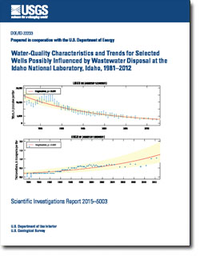Water-quality characteristics and trends for selected wells possibly influenced by wastewater disposal at the Idaho National Laboratory, Idaho, 1981-2012
Links
- More information: USGS Index Page
- Document: Report (7.8 MB pdf)
- Appendixes:
- Download citation as: RIS | Dublin Core
Abstract
The U.S. Geological Survey, in cooperation with the U.S. Department of Energy, analyzed water-quality data collected from 64 aquifer wells and 35 perched groundwater wells at the Idaho National Laboratory (INL) from 1981 through 2012. The wells selected for the study were wells that possibly were affected by wastewater disposal at the INL. The data analyzed included tritium, strontium-90, major cations, anions, nutrients, trace elements, total organic carbon, and volatile organic compounds. The analyses were performed to examine water-quality trends that might influence future management decisions about the number of wells to sample at the INL and the type of constituents to monitor.
The data were processed using custom computer scripts developed in the R programming language. Summary statistics were calculated for the datasets. Water-quality trends were determined using a parametric survival regression model to fit the observed data, including left-censored, interval-censored, and uncensored data. The null hypothesis of the trend test was that no relation existed between time and concentration; the alternate hypothesis was that time and concentration were related through the regression equation. A significance level of 0.05 was selected to determine if the trend was statistically significant.
Trend test results for tritium and strontium-90 concentrations in aquifer wells indicated that nearly all wells had decreasing or no trends. Similarly, trends in perched groundwater wells were mostly decreasing or no trends; trends were increasing in two perched groundwater wells near the Advanced Test Reactor Complex. Decreasing trends generally are attributed to lack of recent wastewater disposal and radioactive decay.
Trend test results for chloride, sodium, sulfate, nitrite plus nitrate (as nitrogen), chromium, trace elements, and total organic carbon concentrations in aquifer wells indicated that most wells had either decreasing or no trends. The decreasing trends in these constituents are attributed to decrease in disposal of these constituents, as well as discontinued use of the old percolation ponds south of the Idaho Nuclear Technology and Engineering Center (INTEC) and redirection of wastewater to the new percolation ponds 2 miles southwest of the INTEC in 2002.
Chloride (along with sodium, sulfate, and some nitrate) concentrations in wells south of the INTEC may be influenced by episodic recharge from the Big Lost River. These constituent concentrations decrease during wetter periods when there is probably more recharge from the Big Lost River and increase during dry periods, when there is less recharge.
Some wells downgradient of the Central Facilities Area and near the southern boundary of the INL showed increasing trends in sodium concentration, whereas there was no trend in chloride. The increasing trend for sodium could be due to the long term influence of wastewater disposal from upgradient facilities and the lack of trend for chloride could be because chloride is more mobile than sodium and more dispersed in the aquifer system.
Volatile organic compound concentration trends were analyzed for nine aquifer wells. Trend test results indicated an increasing trend for carbon tetrachloride for the Radioactive Waste Management Complex Production Well for the period 1987–2012; however, trend analyses of data collected since 2005 show no statistically significant trend indicating that engineering practices designed to reduce movement of volatile organic compounds to the aquifer may be having a positive effect on the aquifer.
Study Area
| Publication type | Report |
|---|---|
| Publication Subtype | USGS Numbered Series |
| Title | Water-quality characteristics and trends for selected wells possibly influenced by wastewater disposal at the Idaho National Laboratory, Idaho, 1981-2012 |
| Series title | Scientific Investigations Report |
| Series number | 2015-5003 |
| DOI | 10.3133/sir20155003 |
| Year Published | 2015 |
| Language | English |
| Publisher | U.S. Geological Survey |
| Publisher location | Reston, VA |
| Contributing office(s) | Idaho Water Science Center |
| Description | Report: viii, 105 p.; Appendixes A-E |
| Public Comments | DOE/ID-22233 |
| Time Range Start | 1981-01-01 |
| Time Range End | 2012-12-31 |
| Country | United States |
| State | Idaho |
| Datum | North American Datum of 1927 |
| Projection | Universal Transverse Mercator projection, Zone 12 |
| Online Only (Y/N) | Y |
| Additional Online Files (Y/N) | Y |


